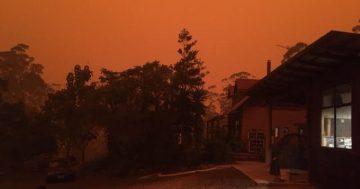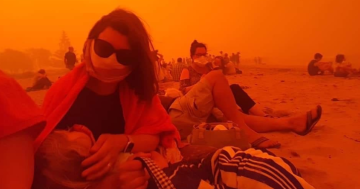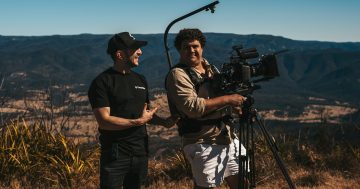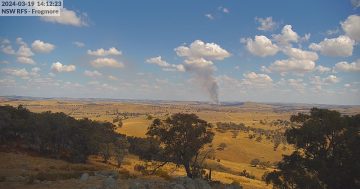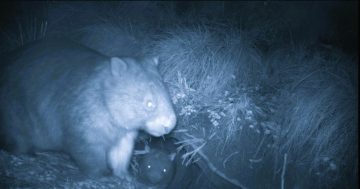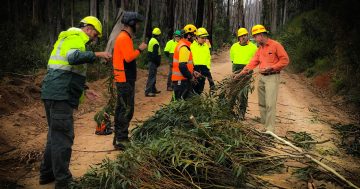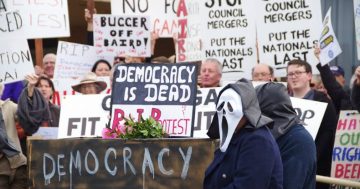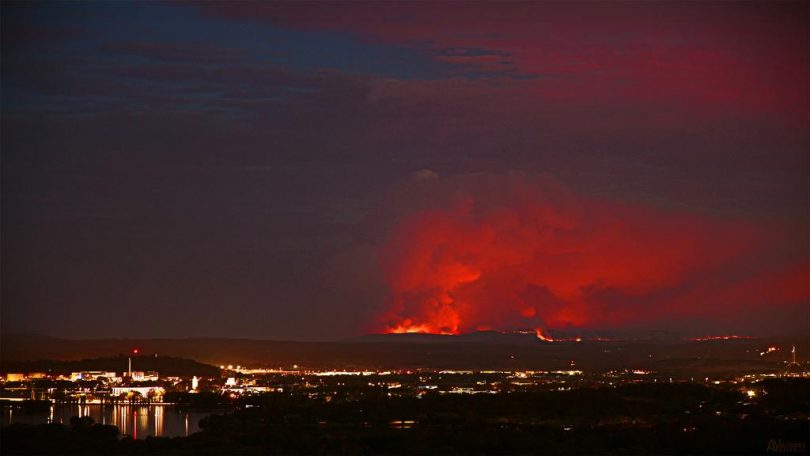
The North Black Range fire as seen from Canberra during the 2019-2020 Black Summer. Photo: AYMcreations.
Last week NSW Coroner Teresa O’Sullivan handed down her findings and recommendations from the Black Summer bushfires inquiry to the state’s police and emergency services, but the Independent Bushfire Group (IBG) says more needs to be done.
Following the inquiry that heard from 190 witnesses in almost 80 days of evidence over two years and scrutinised 44,000 pages of evidence, the State Coroner made 28 recommendations, of which 23 were made directly to the NSW Rural Fire Service (RFS).
The RFS was said to have grappled with “systemic issues of public importance” during the fires that ravaged the state in 2019-20. Those issues included fire prediction warnings, assessment and investigation, communication, risk evaluation, back-burning practices and even vehicle design.
However, IBG Convenor Geoffrey Luscombe said that while they respected the good work done by the coroner, acknowledging the limits of what such a process could do, IBG was shocked that after more than four years there was still no comprehensive and expert review of the worst fires ever in NSW.
“Overall, the disaster-inquiry-disaster cycle is a broken model and does not deliver on the operational lessons needed for next time,” said Mr Luscombe.
“NSW needs an ongoing and independent capability for reviewing and improving disaster operations, like the Inspectors General of Emergency Management that Victoria and Queensland created a decade ago.
“The disasters royal commission after Black Summer recommended exactly that, but NSW has ignored it.”
Mr Luscombe said with the huge workload on fire ’cause and origin’, loss of lives and property, the coronial inquiry could only ever act within its jurisdiction on 41 fires out of the thousands during Black Summer.
“Many tactics and strategies worked well but without proper reviews and publishing the lessons learned, firefighters are not getting the most out of what could be an open learning processes,” said Mr Luscombe.
“The only detailed examination of any Black Summer fire has been done by independent researchers, such as the IBG. The agencies won’t do it, the NSW bushfire inquiry didn’t, and the coroner can’t do the heavy lifting.”
IBG noted several remaining questions that came up in the coronial process, yet remained unsolved, including:
- Many fires started as lightning strikes in remote bushland. Some were put out but others burned on to become the worst disasters.
- What made the difference and what new operational systems are needed to make sure the majority of future lightning ignitions are put out when they are small?
- The Gospers Mountain fire was not declared as a major incident under section 44 of the Rural Fires Act until 16 days after it started when it was out of control. This meant Gospers could not compete against other going fires for the resources needed to put it out soon after lightning ignition. It went on to become the largest forest fire ever seen in NSW and vastly increased the scale of the Black Summer bushfire emergency.
- Have new risk assessment processes for competing fires been developed?
- The Ruined Castle fire in the Blue Mountains was contained, until a large air tanker drop blew it over the line.
- What has been learnt from that?
- There was a delay of many hours in putting firefighters on the ground at the Green Wattle Creek fire when it could have been put out while it was small and burning in mild conditions.
- Has the delay been investigated and what has been done to improve timely response to future lightning ignitions?
- Some fires were contained or slowed by backburning operations. However other fires were significantly expanded and accelerated by backburns that escaped. The NSW bushfire inquiry requested detailed research into this issue but years later only a still secret pilot study has been done.
- Has there been any comprehensive analysis to understand what made the difference?
In October 2020 an initial report of the Royal Commission into National Natural Disaster Arrangements contained 80 recommendations, which were categorised into Commonwealth and state or territory responsibilities.
Minister for Agriculture, Fisheries and Forestry, Murray Watt, announced the completion of all 15 recommendations directed to the Commonwealth on 14 December last year. This progress was noted in the royal commission’s interim report on 20 October, and a final report is expected to be published midway through this year.
Mr Luscombe said the NSW disaster review process needed a complete overhaul, which the State Government must act on now.


